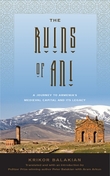Sökning: onr:0bhhjvkvxslfvbgb > The ruins of Ani /
- 1 av 1
- Föregående post
- Nästa post
- Till träfflistan
Palakʻean, Grigoris: Nkaragrutʻiwn Anii aweraknerun.
The ruins of Ani / Krikor Balakian ; translated and with an introduction by Peter Balakian with Aram Arkun.
- Palakʻean, Grigoris, 1876-1934 (författare)
- Balakian, Peter, 1951- (översättare, förord)
- Arkun, Aram (översättare, förord)
- ISBN 9781978802919
- Publicerad: New Brunswick, New Jersey : Rutgers University Press, [2019]
- Copyright: ©2019
- Engelska xxxix, 120 pages
- Bok
Innehållsförteckning
Sammanfattning
Ämnesord
Inställningar
Hjälp
Stäng
- Description of Ani's ruins, illustrated -- I: History of Ani. The founding and flourishing of Ani ; The sale of Ani ; The Seljuk invasions and the destruction of Ani -- II: Topography of Ani -- III: Description of the ruins of Ani. The external walls ; The cathedral ; St. Krikor [St. Gregory] the Illuminator Church ; Church of the Holy Savior ; Church of the Holy Apostles ; The Apughamrents Church of St. Krikor [St. Gregory] ; Kakgashen Church of St. Krikor [St. Gregory] ; The Georgian Church ; The palace of the Pakradunis ; Ani's residence of the Catholicos ; Ani's citadel ; Ghoshavank near Ani -- IV: Scholarship on Ani. The Armenian architectural style ; Plan of Ani (illustration) ; The present excavations of Ani ; His Holiness Catholicos Matteos II's voyage to Ani ; The poem of Ani -- Glossary.
- "Ani is a ruined medieval Armenian city now situated in Turkey's province of Kars, next to the closed border with Armenia. Between 961 and 1045, it was the capital of the Bagratid Armenian kingdom that covered much of present-day Armenia and eastern Turkey.The Ruins of Ani was originally written by Grigoris Balakian in 1910. Though there were a number of works from the same period written about Ani by people who participated in excavations in the city, the history and significance of Ani was still not well known to Western Armenian readers in 1910, and Balakian's goal was to inform them about the importance of Ani for the Armenian past and Armenian culture or civilization. Thus, it is a basic summary of what was known about Ani at the time, historically and archaeologically. Balakian states that this work is both a guide for travelers who wish to visit Ani, and an introduction to those who do not have the means to actually travel there. That book has now been translated into English by his grandnephew, Pulitzer Prize-winning poet and New York Times bestselling author Peter Balakian, along with Aram Arkun. Peter Balakian has also provided an introduction that frames the original text as essential to issues surrounding the Armenian Genocide and its complex aftermath with Turkish denialism. He also details the Ani restoration project now underway"--
- "From the tenth to the thirteenth centuries, the city of Ani was the jewel of the Armenian kingdom, renowned far and wide for its magnificent buildings. Known as the city of 1,001 churches, Ani was a center for artistic innovation, and its architecture is a potential missing link between Byzantine and Gothic styles. By the fifteenth century, Ani was virtually abandoned, its stunning buildings left to crumble. Yet its ruins have remained a symbol of cultural accomplishment that looms large in the Armenian imagination. [This book] is a unique combination of history, art criticism, and travel memoir that takes readers on a journey into the splendor of Armenia's medieval past. Today, Ani is a popular tourist site in Turkey, but the presentation of the city has been falsified by the Turkish government in order to erase Armenian history in the wake of the Armenian Genocide. Written by young priest Krikor Balakian in 1910, just a few years before the Armenian Genocide, this important book has been unknown to the wider world for more than a century, and this first English edition eloquently renders the book's vivid descriptions and lyrical prose. The Ruins of Ani also offers a powerful and poignant counterpart to Balakian's acclaimed genocide memoir Armenian Golgotha. With a new introduction that explores Ani's continued relevance in the twenty-first century, this edition raises questions about the preservation of major historic monuments in the face of post-atrocity campaigns of cultural erasure."--Dust jacket.
Ämnesord
- Arkitektur (sao)
- Övergivna städer (sao)
- Architecture -- Turkey -- Ani. (LCSH)
- Architecture (LCSH)
- Extinct cities (LCSH)
- Armenien (sao)
- Ani (Extinct city) (LCSH)
- Armenia -- History -- Bagratuni dynasty, 885-1045. (LCSH)
- 885-1045 (fast)
Genre
- History. (fast)
Indexterm och SAB-rubrik
- Noa Geografi: Främre Asien
Klassifikation
- 956.6/26 (DDC)
- Noa (kssb/8)
Titeln finns på 1 bibliotek.
Bibliotek i västra Sverige (1)
Ange som favorit- Biblioteken i Göteborg (Gbg)Ange som favorit
- Bibliotekets lokala katalog
- Utlånad?Öppettider, adress m.m.
- 1 av 1
- Föregående post
- Nästa post
- Till träfflistan
Sök vidare
Hjälp
- Fler titlar av
- Palakʻean, Grigoris, ...
- Balakian, Peter, 195 ...
- Arkun, Aram
- Fler titlar om
- 885-1045
- Arkitektur
- Övergivna städer
-
- Architecture
- Architecture
- och Turkey
- och Ani.
- Architecture
- Extinct cities
- visa fler...
- Armenien
- Ani (Extinct city)
- visa färre...
- Fler titlar i denna genre
- History.
Sök utanför LIBRIS
Hjälp
- Sök vidare i:
- Google Book Search
- Google Scholar
- LibraryThing
Kungliga biblioteket hanterar dina personuppgifter i enlighet med EU:s dataskyddsförordning (2018), GDPR. Läs mer om hur det funkar här.
Så här hanterar KB dina uppgifter vid användning av denna tjänst.
Copyright © LIBRIS - Nationella bibliotekssystem

